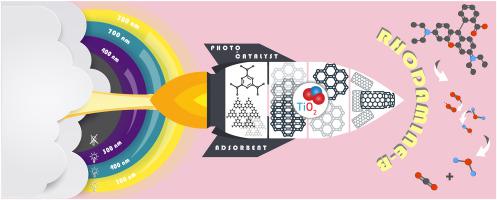当前位置:
X-MOL 学术
›
Environ. Res.
›
论文详情
Our official English website, www.x-mol.net, welcomes your feedback! (Note: you will need to create a separate account there.)
Improved photocatalytic performance of TiO2/carbon photocatalysts: Role of carbon additive
Environmental Research ( IF 8.3 ) Pub Date : 2024-03-18 , DOI: 10.1016/j.envres.2024.118672 C. Abreu-Jaureguí , L. Andronic , A. Sepulveda-Escribano , J. Silvestre-Albero
Environmental Research ( IF 8.3 ) Pub Date : 2024-03-18 , DOI: 10.1016/j.envres.2024.118672 C. Abreu-Jaureguí , L. Andronic , A. Sepulveda-Escribano , J. Silvestre-Albero

|
A series of TiO – based photocatalysts have been prepared by the incorporation of 10 wt% of various carbon-based nanomaterials as modifying agents to titania. More specifically, commercial TiO P25 was modified through a wet impregnation approach with methanol with four different carbon nanostructures: single-walled carbon nanotubes (SWCNTs), partially reduced graphene oxide (prGO), graphite (GI), and graphitic carbon nitride (gCN). Characterization results (XPS and Raman) anticipate the occurrence of important interfacial phenomena, preferentially for samples TiO/SWCNT and TiO/prGO, with a binding energy displacement in the Ti 2p contribution of 1.35 eV and 1.54 eV, respectively. These findings could be associated with an improved electron-hole mobility at the carbon/oxide interface. Importantly, these two samples constitute the most promising photocatalysts for Rhodamine B (RhB) photodegradation, with nearly 100% conversion in less than 2 h. These promising results must be associated with intrinsic physicochemical changes at the formed heterojunction structure and the potential dual-role of the composites able to adsorb and degrade RhB simultaneously. Cyclability tests confirm the improved performance of the composites (e.g., TiO/SWCNT, 100% degradation in 1 h) due to the combined adsorption/degradation ability, although the regeneration after several cycles is not complete due to partial blocking of the inner cavities in the carbon nanotubes by non-reacted RhB. Under these reaction conditions, Rhodamine-B xanthene dye degrades via the de-ethylation route.
中文翻译:

TiO2/碳光催化剂的光催化性能提高:碳添加剂的作用
通过掺入 10 wt% 的各种碳基纳米材料作为二氧化钛的改性剂,制备了一系列 TiO 基光催化剂。更具体地说,商业TiO P25通过甲醇湿浸渍方法用四种不同的碳纳米结构进行改性:单壁碳纳米管(SWCNT)、部分还原氧化石墨烯(prGO)、石墨(GI)和石墨氮化碳(gCN) 。表征结果(XPS 和拉曼)预测了重要界面现象的发生,特别是 TiO/SWCNT 和 TiO/prGO 样品,Ti 2p 贡献中的结合能位移分别为 1.35 eV 和 1.54 eV。这些发现可能与碳/氧化物界面处电子空穴迁移率的改善有关。重要的是,这两个样品构成了最有前途的罗丹明 B (RhB) 光降解光催化剂,在不到 2 小时内几乎实现了 100% 的转化。这些有希望的结果必定与所形成的异质结结构的内在物理化学变化以及能够同时吸附和降解 RhB 的复合材料的潜在双重作用有关。循环性能测试证实了复合材料性能的改进(例如,TiO/SWCNT,1 小时内 100% 降解),这是由于结合的吸附/降解能力,尽管由于内部空腔的部分堵塞,几个循环后的再生并不完全。由未反应的RhB制备碳纳米管。在这些反应条件下,罗丹明-B 呫吨染料通过脱乙基化途径降解。
更新日期:2024-03-18
中文翻译:

TiO2/碳光催化剂的光催化性能提高:碳添加剂的作用
通过掺入 10 wt% 的各种碳基纳米材料作为二氧化钛的改性剂,制备了一系列 TiO 基光催化剂。更具体地说,商业TiO P25通过甲醇湿浸渍方法用四种不同的碳纳米结构进行改性:单壁碳纳米管(SWCNT)、部分还原氧化石墨烯(prGO)、石墨(GI)和石墨氮化碳(gCN) 。表征结果(XPS 和拉曼)预测了重要界面现象的发生,特别是 TiO/SWCNT 和 TiO/prGO 样品,Ti 2p 贡献中的结合能位移分别为 1.35 eV 和 1.54 eV。这些发现可能与碳/氧化物界面处电子空穴迁移率的改善有关。重要的是,这两个样品构成了最有前途的罗丹明 B (RhB) 光降解光催化剂,在不到 2 小时内几乎实现了 100% 的转化。这些有希望的结果必定与所形成的异质结结构的内在物理化学变化以及能够同时吸附和降解 RhB 的复合材料的潜在双重作用有关。循环性能测试证实了复合材料性能的改进(例如,TiO/SWCNT,1 小时内 100% 降解),这是由于结合的吸附/降解能力,尽管由于内部空腔的部分堵塞,几个循环后的再生并不完全。由未反应的RhB制备碳纳米管。在这些反应条件下,罗丹明-B 呫吨染料通过脱乙基化途径降解。



























 京公网安备 11010802027423号
京公网安备 11010802027423号